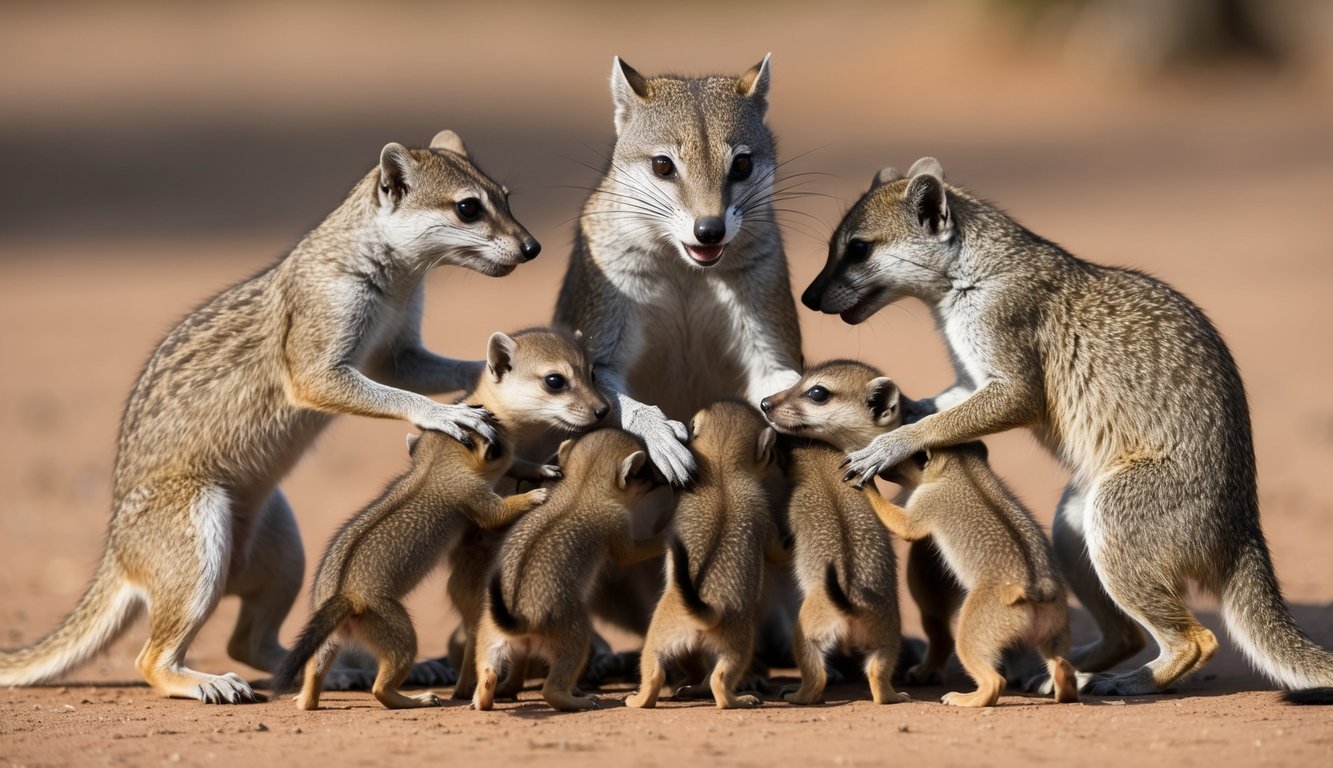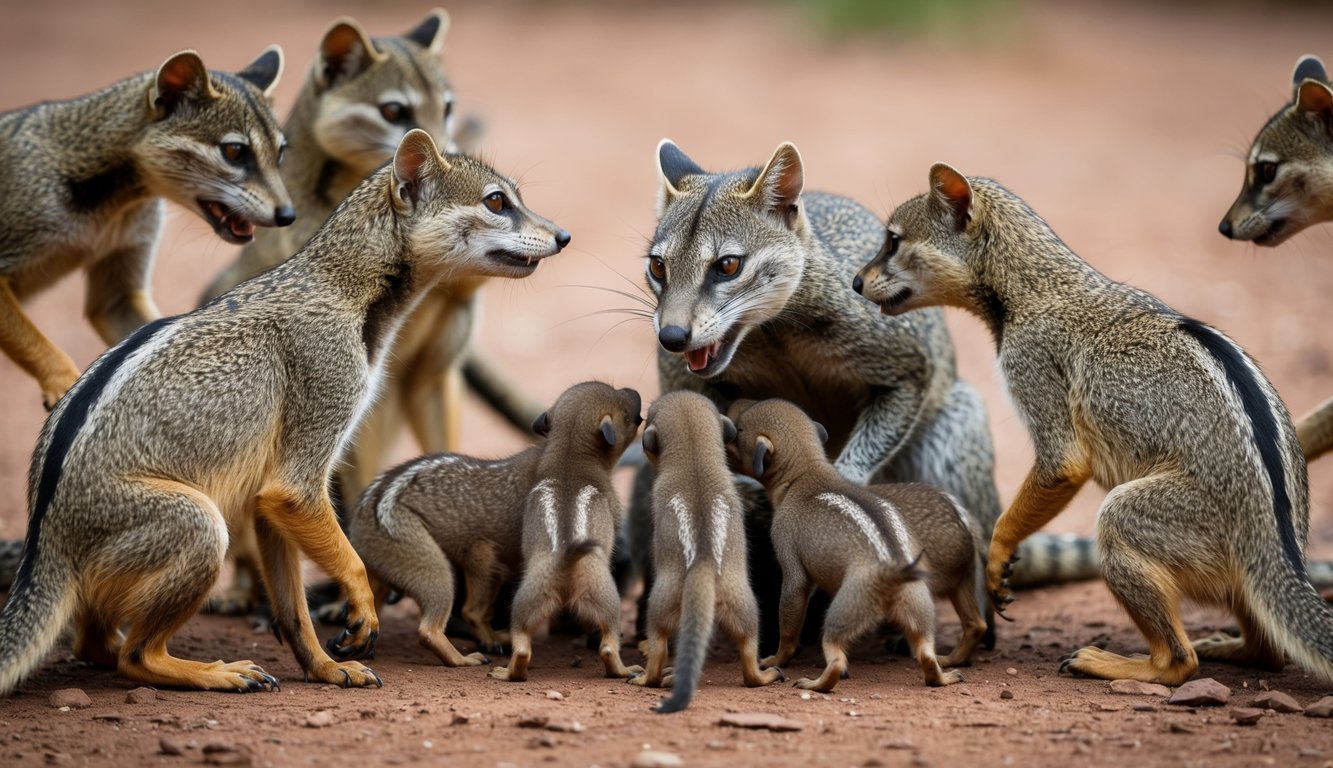PsychNewsDaily Publishers
100 Summit Drive
Burlington, MA, 01803
Telephone: (320) 349-2484
PsychNewsDaily Publishers
100 Summit Drive
Burlington, MA, 01803
Telephone: (320) 349-2484
Banded mongooses exhibit communal care, with mothers synchronizing births and collectively nurturing pups, enhancing survival rates and fostering cooperation within their social groups.

In the wild, banded mongooses display a unique way of creating a fair society. This small mammal lives in groups, where the mothers synchronize their births, often having their pups on the same night. This teamwork results in all mothers caring for the young as if they were their own.
This behavior fosters a supportive environment, ensuring that every pup receives the attention and care it needs to thrive.
Unlike many other species, mongoose parents do not know which pups are theirs, leading to reduced inequality among the group. This setup helps to prevent favoritism and creates a sense of community.
By sharing responsibilities, these mothers enhance the survival rates of all the pups, showing that cooperation is key to their social structure.
The dynamic between the mothers highlights how care and reproduction play vital roles in their society. The bond formed through shared parenting not only strengthens their group but also ensures that no pup is left behind. This fascinating approach offers insights into how nature can create fairness and cooperation among its creatures.

Banded mongooses have developed interesting social behaviors that promote fairness among their young. Their communal care system and social structure play crucial roles in minimizing inequality within their groups.
In banded mongoose groups, mothers do not only care for their own offspring. Instead, they share the responsibility of rearing all the pups. This behavior is vital for creating a supportive environment.
When all mothers give birth on the same night, it ensures that each pup receives attention from multiple caregivers. With this system, no single pup is left without support.
The idea is that mothers cannot easily identify their own young. Because of this uncertainty, they tend to assist the pups that appear to need it the most, boosting survival chances for all. This helps reduce inequality at birth.
Banded mongooses have well-defined social structures and hierarchies. Each group typically contains around 20 to 50 members. Leaders are often the dominant females, guiding the pack and making important decisions.
Within this hierarchy, roles are often fluid. While dominant members may lead, all mongooses contribute to the communal care of the young.
This system not only strengthens bonds among members but also encourages cooperation. By working together, they enhance their survival and the well-being of the entire group.

Mongooses have interesting ways of reproducing and taking care of their young. Their social structure promotes shared responsibility, which helps the survival of the pups.
Mongooses usually give birth at the same time. This is known as birth synchrony. By all mothers giving birth on the same night, they create a stable environment for the pups.
This method means that every pup has a better chance of getting enough food. Since all mothers are focused on caring for the young, it helps to balance the needs of all the pups.
When food is scarce, these practices can lead to higher survival rates. This system reduces competition among siblings and ensures that weaker pups still receive proper care.
In mongoose groups, parental investment is crucial. Since mothers cannot identify their own pups, they treat all the young equally. This encourages mothers to invest time and resources in every pup they see.
With the shared care from multiple mothers, the survival chances of the pups increase. They gain access to food, warmth, and protection from predators.
Research shows that when parents help raise each other’s young, it leads to healthier and more resilient populations. This teamwork among mothers demonstrates the effectiveness of their social structure in promoting the well-being of future generations.

Mongooses are adaptable creatures that thrive in various environments. Their diet plays a significant role in shaping their social behavior and interactions within their groups.
Mongooses can live in diverse habitats, including savannas, grasslands, forests, and deserts. They are found primarily in Africa and parts of Asia. These small mammals have developed skills to survive in different conditions.
Key adaptations include:
These adaptations ensure mongooses can find food and shelter while avoiding dangers in their habitats.
Mongooses are opportunistic feeders. Their diet mainly consists of insects, small rodents, reptiles, birds, and occasionally fish. This varied diet influences their social interactions.
When foraging for food, mongooses work together, which strengthens their bonds. They often share food, ensuring pups receive care from all members. The need to hunt in groups creates a sense of community among mongooses.
Common food items include:
This cooperative feeding behavior highlights how diet directly impacts their social structure and contributes to their unique way of life.

Mongoose societies face various threats that can impact their survival. These challenges include natural predators, human influence, and diseases. Understanding these factors is essential to grasping how mongooses maintain their social structure.
Mongooses are preyed upon by larger animals such as birds of prey and snakes. These predators can significantly reduce mongoose populations, especially in vulnerable areas.
Human activity also poses a serious threat. Habitat destruction from urban development reduces the space where mongooses can live and find food.
Feral cats are another significant challenge. They not only compete with mongooses for food but also directly hunt them. This addition of a human-related predator creates stress on mongoose groups, potentially disrupting their social dynamics.
Diseases can spread quickly among mongoose groups, especially in closer communities. Parasitic infections are common, and they can spread through contact with infected animals or contaminated environments.
Managing these diseases is crucial for the health of the group. Mongooses may show signs of illness, such as lethargy or decreased activity, which can impact their ability to care for pups.
Conservation efforts aimed at reducing disease spread focus on monitoring health and providing clean environments. These measures help ensure that mongooses can thrive despite the challenges they face.

Mongooses play an interesting role in human society. Their presence influences culture, beliefs, and ecosystems. Understanding these interactions helps people appreciate mongooses and their environment.
In various cultures, mongooses are seen as symbols of protection and good luck. In Uganda, they are often connected to local folklore. Some stories depict mongooses as brave animals that can fight snakes, making them revered in communities.
In South Africa, mongooses appear in legends. People believe they can ward off evil spirits. These beliefs lead to a respectful relationship with mongooses. They are sometimes protected as part of local traditions.
In addition, mongooses are featured in art and stories. They inspire people in different ways, showing their impact on cultural identity.
Mongooses play a crucial role in their habitats. They help control pest populations, which is important for maintaining balance in ecosystems.
By eating rodents and insects, mongooses help farmers. Their presence can reduce crop damage. This benefit makes them valuable to agriculture.
In regions like Uganda and South Africa, mongooses contribute to biodiversity. Their hunting habits influence the types of creatures present in an area. They help balance food webs by being both predators and prey.

Mongoose society has unique ways of sharing parenting. Understanding their social structures, the role of alloparenting, and the differences between communal and solitary childcare can shed light on these fascinating creatures. Here are some common questions about their parenting practices.
Mongoose mothers often give birth on the same night. This timing helps create a sense of shared responsibility. Since each mother cannot identify her own pups, all mothers tend to care for all the young in the group.
Mongooses live in groups called mobs. These mobs have strong social bonds. The close interactions among members encourage cooperation in raising young, making it easier for mothers to care for pups collectively.
Alloparenting is when individuals in a group help care for the young that are not their own. In mongoose mobs, several mothers participate in nursing and protecting pups. This behavior fosters a supportive environment for all young, improving their chances of survival.
Solitary animals typically raise their young alone, limiting support. In contrast, mongoose societies rely on group dynamics for childcare. The shared parenting approach allows mongooses to protect and nurture their pups more effectively.
Communal care enhances the survival rate of young mongooses. By having multiple mothers watch over the pups, threats from predators are reduced. The young benefit from more attention and resources that a group can provide.
This system helps ensure that all pups have equal chances at life. It also strengthens social ties within the mob.
The communal approach promotes unity and cooperation, which are vital for the group’s overall success.